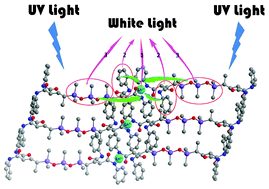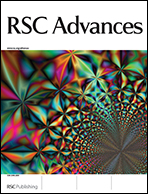White photoluminescent material based on a functional polysiloxane complex with lanthanide ions (Eu3+ and Dy3+)†
Abstract
This paper reports on a white light-emitting, polysiloxane-based material obtained by coordinating lanthanide ions (Eu3+ and Dy3+) into α, ω-N,N′-diphenylmalonamide terminated polydimethylsiloxane (PMP). PMP is a new functional polysiloxane designed and synthesized in this work. The luminescence emissions of the raw materials and the composite material were measured. The composite material produced a white luminescence with Commission Internationale de l'Eclairage coordinates of (0.32, 0.34). The polysiloxane backbone plays a role in the luminescence performance of both the PMP and the composite material. Interactions between the terminal groups of the PMP host and the rare earth ions, as revealed by infrared and fluorescence data, contribute to the emission via the antenna effect. The surface morphologies of PMP and the composite material are smooth platforms piled up by layer stacking, as observed with


 Please wait while we load your content...
Please wait while we load your content...